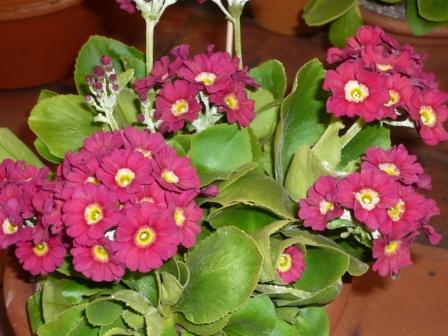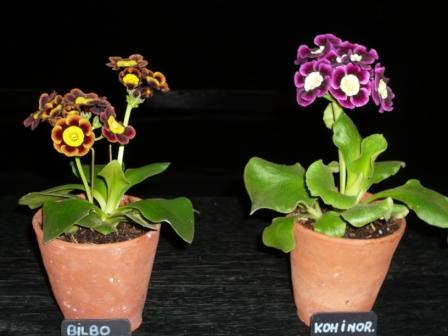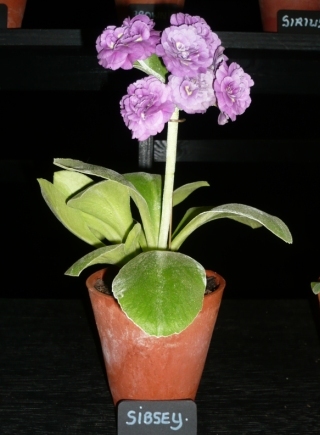Growing Excellent Auriculas
This spring has been a good one for my Auriculas. I have been please with a powder blue flower that I hope to propagate by division in July. First I will water well and add some dilute feed.
These Alpine Auriculas look excellent when grown in 3 inch pots. The ‘Long Tom’ pots are silghtly taller than the traditional pot and are useful as Auricula tend to grow a ‘carrot root’ used to anchor the plant in the wild. Alpine Auriculas have either a golden yellow or cream centre surrounding the tube.
Show Auriculas are considered to be the star Auricula plants and must have a ring of dense Farina around the eye of the flower. Selfs (all one colour) and Edges including most stripes have an outside edge composed of leaf tissue such as the ‘Orlando’ a grey edged show Auricula. Green edges usually have larger flowers. Stripes have recently been reintroduced with Monmouth Star having red petals with yellow rays out to the flowers edge.
Double Auricula ‘Sibsey‘ is a blue to purple flower and can be found at Specialist grower Angus Auriculas. Doubles arise from mutations of border or garden Auriculas and were amongst the first novelties cultivated and shown. There is now an increasing number of doubles including striped doubles at NAPS shows. The Fantasia variety is deep maroon with white frosting a real eye-catcher
Border or Garden Auriculas have old names like Dusty Miller, Recklasses and Ricklers. Only a few have ‘Farina’ the white powder found on leaves and flowers that resembles flour or meal which is a must on Show Auriculas. Some are European primula hybrids and occasional are scented. Best grown in a position that gives them shade from midday sun. Water in very dry spells but plant in well drained soil. Ideal for partially shaded positions on rockeries or borders, or spring flower beds, pots, tubs

Cultivation Tips
- Auriculas are hardy perennials that endure severe weather conditions without difficulty. Show Auriculas are easily damaged by rain or even Bees as the farina is an important part of the display when judging.
- Grown in pots give them plenty of ventilation and a good loam or John Innes No.2 (with extra grit and open humus.) Re pot annually after flowering.
- Offsets are the way to propagate new named varieties of Auricula. Garden Auricula make clumps and can be split or divided.
- Auriculas can be slow to establish themselves but Alpines and doubles grow stronger.
- Water copiously between February and May when the plants are growing and give a half strength feed every couple of weeks.
- Too much heat and water in summer can be fatal for pot grown plants in summer so try to keep roots cool.
- Finish repotting be September and give a high potash low nitrogen feed for Autumn.
More information on Auriculas
National Auricula and primula Society for details of shows and rules for showing
Auricula Society – How to Look After Prize Plants
- Try not to splash leaves when watering
- Pot in four inch pots with 4 parts John Innes No.2 to two parts grit
- Remove dead leaves to prevent botrytis
- Protect from rain and direct sunlight
- treat for vine weevils
For some good flowers from a real enthusiast
Auriculas for Everyone
Mary A. Robinson.
GMC Publications.
ISBN 1-86108-149-9
£14.50 plus £2.50 p&p
Auriculas
G.Baker & P.Ward
B.T.Batsford Ltd.
ISBN 0-7134-7366-5
The Auricula: History, Cultivation and Varieties Allan Guest
Auriculas – Their Care and Cultivation
B.Hyatt Cassell, London.
ISBN 0-304-34070-7




5 thoughts on “Growing Excellent Auriculas”
4 years is a longtime even for slow growers. Do they need splitting replanting in fresh compost and more water
Great article – I hope your auriculas are looking good this year, ours are simply fabulous this year, they must like the warm spring.
Comments are closed.